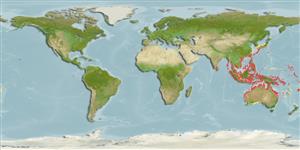Issue
Regarded as nomen dubium (unavailable) in Randall et al., 2014 (Ref. 95583:21)
Environment: milieu / climate zone / depth range / distribution range
Ökologie
seewasser; brackwasser riff-verbunden. Tropical
Indo-West Pacific: southwest Sumatra to Bali Strait, and Malaysia (Ref. 5756).
Size / Gewicht / Alter
Maturity: Lm ? range ? - ? cm
Max length : 15.0 cm NG Männchen/unbestimmt; (Ref. 27550)
Inhabits coral reefs and rocky areas (Ref. 27550). Enters estuaries (Ref. 27550). Feeds on crustaceans and polychaete worms (Ref. 27550).
Life cycle and mating behavior
Geschlechtsreife | Fortpflanzung | Ablaichen | Eier | Fecundity | Larven
Gloerfelt-Tarp, T. and P.J. Kailola, 1984. Trawled fishes of southern Indonesia and northwestern Australia. Australian Development Assistance Bureau, Australia, Directorate General of Fishes, Indonesia, and German Agency for Technical Cooperation, Federal Republic of Germany. 407 p. (Ref. 5978)
IUCN Rote Liste Status (Ref. 130435: Version 2024-2)
Bedrohung für Menschen
Harmless
Nutzung durch Menschen
Tools
Zusatzinformationen
Download XML
Internet Quellen
Estimates based on models
Preferred temperature (Ref.
123201): 27 - 29.3, mean 28.8 °C (based on 1850 cells).
Phylogenetic diversity index (Ref.
82804): PD
50 = 0.5000 [Uniqueness, from 0.5 = low to 2.0 = high].
Bayesian length-weight: a=0.01380 (0.00591 - 0.03225), b=3.02 (2.83 - 3.21), in cm total length, based on LWR estimates for this Genus-body shape (Ref.
93245).
Trophic level (Ref.
69278): 3.3 ±0.38 se; based on food items.
Widerstandsfähigkeit (Ref.
120179): hoch, Verdopplung der Population dauert weniger als 15 Monate. (Preliminary K or Fecundity.).
Fishing Vulnerability (Ref.
59153): Low vulnerability (10 of 100).
Nutrients (Ref.
124155): Calcium = 91.6 [46.4, 150.3] mg/100g; Iron = 0.688 [0.418, 1.148] mg/100g; Protein = 18.8 [17.7, 19.9] %; Omega3 = 0.121 [0.073, 0.202] g/100g; Selenium = 21.7 [11.6, 40.8] μg/100g; VitaminA = 74.8 [21.9, 250.4] μg/100g; Zinc = 1.66 [1.12, 2.39] mg/100g (wet weight);
